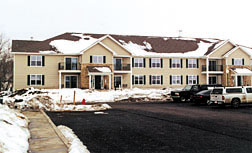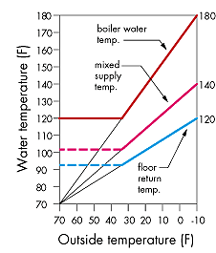
Hartwig Plumbing & Heating
Harvard, Ill.
Harvard Apartments
For each of the last few years I've had the privilege of reviewing the many projects submitted for the RPA System Showcase awards. I always look forward to seeing how radiant heating professionals across the country combine the latest design skills, modern hardware, and true craftsmanship to create unique systems precisely matched to the needs of their clients.The panel of reviewers looks at the technical execution of each project as well as the professionalism of the submittal itself. Projects that win must demonstrate a synergy of sound technical design, appropriateness for the constraints imposed, professional installation, and good documentation. After all, the winners go on to represent the best the radiant heating industry has to offer.
The greatest impression for me in this year's winning entries is the project that took Commercial Hydronics honors. Galina Cos., a Madison, Wis., real estate developer and manager, was planning an apartment complex in Harvard, Ill., a rural town about 90 northwest of Chicago. Galina management did have some previous experience using hydronic radiant floor heating in other developments. They knew radiant systems could reduce heating costs, and since they planned to include the heating cost in the rent, such savings were obviously desirable.
Still, the construction budget for the first building was tight. And the possibility of using a forced air system was not ruled out. The bottom line: If this project was going to get radiant heating, the system would have to make the most of every dollar.
When presented with the plans for the building, Harvard contractor Chadd Hartwig, Hartwig Plumbing & Heating, teamed up with his distributor team, Marty Nuzik, Alan Shwartz, and Piotr Zelasko of Park Supply, Chicago. Together they considered several different approaches, finally settling on a design by Zelasko that delivered the low installation and operating cost Galina was after.

Simple Yet Elegant
In the process of planning the system Zelasko recalled several concepts he'd learned at an RPA Advanced Controls seminar. Soon his design employed techniques such as proportional reset control, boiler inlet temperature protection, and a high temperature drop within the distribution system.Proportional reset describes a situation in which a hydronic subsystem with a manually set mixing valve will automatically vary its supply water temperature (e.g. reset) as the hot water source supplying it is reset. Figure 1 shows this relationship. Notice how the water temperature in the mixed subsystem (shown as the pink line) decreases "proportionally" to the decrease in boiler water temperature (shown as the red line).
Boiler inlet temperature protection is a must when connecting any conventional boiler to a low temperature distribution system. If omitted the boiler can operate at temperatures low enough to cause sustained condensation of water vapor and other compounds in the exhaust stream. The resulting corrosion will be swift and in many cases severe. Condensing flue gases can eat through a standard 26 gauge galvanized vent connector in a matter of months.
Finally, the ability to work with a large temperature difference between the supply and return sides of any hydronic system is an opportunity that should not be missed. Doubling the temperature drop of the distribution system cuts the flow rate requirement in half. This reduces pipe size, circulator size, and even more importantly, lowers the operating cost of the circulator over a long system life. In short, high DeltaT is the holy grail of hydronic heating design.

Hot water from the boiler loop is supplied to the 1-inch PEX-AL-PEX "building loop" at 180 degrees F under design load conditions. The building loop is set up as a two-pipe reverse return system with several crossover bridges made of 1/2-inch PEX-AL-PEX tubing. The two-pipe reverse return layout of the building loop is self-balancing, with each crossover bridge operating at a constant flow rate of 0.8 gallons per minute.
Each crossover bridge has a pair of closely spaced tees that lead off to the radiant floor subsystem in a given apartment. Hot water is drawn into the radiant subsystem from the upstream tee and mixed with cooler water from the return manifold. The mix proportions are controlled by two manually set globe valves. Once set, these valves do not modulate (as do thermostatic and motorized mixing valves).
At design load conditions the water temperature on the supply side of the building loop is 180 degrees F. The water temperature supplied to the floor circuits is approximately 140 degrees F with a 20-degree F temperature drop between the supply and return manifolds. The water temperature on the return side of the building loop is 120 degrees F. The temperature drop of the building loop under these conditions is 60 degrees F. Each gallon per minute of flow in the building loop carries 30,000 Btu/hour along for the ride. The total building loop flow rate of 6.4 gpm is easily handled by a 1-inch pipe, yet conveys 192,000 Btu/hour from the mechanical room to the building. That's the magic of a high DeltaT.
As outside temperatures rise, the building loop temperature is reduced from a design value of 180 degree F., down to about 120 degrees F using a boiler reset control. Since the mix proportions remain unchanged, the water supplied to the floor circuits automatically reduces to about 102 degrees F when the outside temperature is about 34 degrees F.
At higher outside temperature, or during periods of internal heat gain, the thermostat in each apartment interrupts operation of the floor circulator as necessary to prevent overheating. To minimize short cycling, the reset control automatically widens the operating differential of the boiler as the outdoor temperature increases. Resetting the boiler water temperature also improves seasonal efficiency and hence decreases fuel use.
The boiler loop contains a three-way thermostatic mixing valve set to protect the boiler from unacceptably low inlet temperatures (about 110 to 120 degrees F for the boiler used). Following a cold start, this valve reroutes water from the boiler outlet back to the inlet. The boiler quickly warms above the dewpoint of its exhaust gases. After the boiler has warmed up, the valve allows hot water to flow to the closely spaced tees where the building loop connects to the boiler loop. Heat that initially circulated in a holding pattern between the boiler and three-way valve is now released to the waiting loads.
The process is comparable to making sure your truck's engine has revved up before you start letting out the clutch. This valve also protects the boiler from low inlet temperatures in the event several apartments are simultaneously recovering from cool slab conditions.
Professional Documentation
Another aspect of the project submittal that grabbed my attention was its excellent documentation. The design department at Park Supply uses a program called Visio Technical to document its hydronic system designs.When combined with a description of operation, well drawn piping and electrical schematics will help future heating technicians understand how the system operates, and expedite service if necessary. Such drawings also convey professionalism to clients who seek it.
The diligence of Hartwig Plumbing & Heating and Park Supply in convincing the Galina Cos. to use radiant floor heating, and then delivering a system that lives up to expectations has paid off. Several more apartment buildings are being planned with hydronic radiant floor heating. These buildings will get systems in which the basic concepts used on the first system are further refined.
One concept being evaluated is the use of a multiple boiler system in which the boiler loop temperature will again be partially reset, allowing proportional reset of the radiant floor circuits in each apartment. The reset control will be set to limit the lower end of the boiler loop temperature to minimize flue gas condensation.
Another avenue being explored is the use of a variable speed injection pump between the boiler loop and the building loop. This approach would allow full reset of the building loop temperature while simultaneously protecting the boiler from low inlet temperatures.
The system at the Harvard Apartments doesn't have all the bells and whistles that other hydronic radiant floor systems submitted for RPA System Showcase awards do. What it does have is a synergy of good design concepts, attention to detail, and true value engineering. It's a system that puts design skills, some learned at RPA seminars, into practice to meet the needs of the client.
The fact this building got a radiant floor heating system testifies to the diligence, teamwork, and "can do" attitudes on the part of the heating contractor, designer, and wholesaler. They pulled together to prove that radiant heating technology in the hands of knowledgeable professionals can provide superior comfort as well as value. To me these are the attributes of a winner.
Second Place:
Hawthorne Heating & Air Conditioning
Wauconda, Ill.
Third Place:
Advanced Radiant Design Inc.
Stone Ridge, N.Y.

